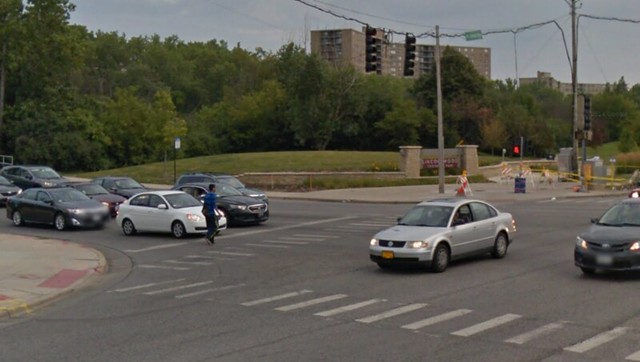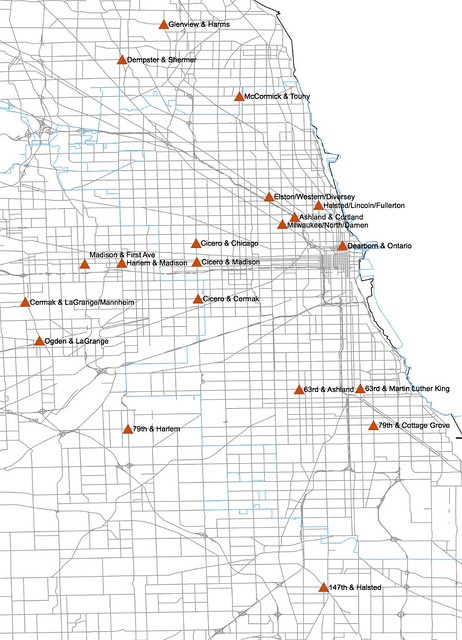
The Active Transportation Alliance was instrumental in creating the Transit Future campaign, with the goal of creating a dedicated funding source for regional transit. Now they’re also pushing for dedicated funding for pedestrian infrastructure, while raising awareness of Chicagoland’s many hazardous intersections, with their new Safe Crossings initiative.
“It’s really important that we recognize the challenges that pedestrians face across the region,” Active Trans’ director of campaigns, Kyle Whitehead, told me. “People tend to assume that these dangerous and difficult intersections are going to stay that way. We want people to realize that there are proven solutions to address these issues. If we can raise awareness and muster resources, there’s the potential to solve these problems throughout the region.”
This morning, Active Trans released a list of ten of the most dangerous intersections in the city of Chicago, and ten of the most hazardous junctions in suburban Cook County. Topping the urban list is the notoriously chaotic North/Damen/Milwaukee intersection in Wicker Park, with 43 reported pedestrian and bike crashes between 2006 and 2012. In the ‘burbs, the worst-ranked junction is Skokie’s McCormick and Touhy intersection, where two six-lane roads cross next to the North Shore Channel Trail bike-and-pedestrian path.
The crash data, provided by the Illinois Department of Transportation, was only one of the factors Active Trans used to compile the lists. They also incorporated feedback from their planning and outreach staff, plus public input. The group received more than 800 responses to an online survey that was posted on their blog, shared via social media, and emailed to members. Here are the full lists:
CHICAGO
| Intersection/Crossing | Bike/Ped Crashes |
| Milwaukee/North/Damen | 43 |
| Cicero and Chicago | 38 |
| Halsted/Lincoln/Fullerton | 37 |
| 79th and Cottage Grove | 36 |
| Dearborn and Ontario | 36 |
| Ashland and 63rd | 33 |
| Cicero and Madison | 31 |
| Ashland and Cortland | 29 |
| 63rd and King | 24 |
| Elston/Western/Diversey | 21 |
SUBURBS
| Intersection/Crossing | City | Bike/Ped Crashes |
| McCormick and Touhy | Skokie | 18 |
| Cermak and Cicero | Cicero | 17 |
| Cermak and LaGrange/Manheim | Westchester | 12 |
| Dempster and Shermer | Morton Grove | 11 |
| Ogden and La Grange Rd | LaGrange | 11 |
| Glenview and Harms Rd | Glenview | 10 |
| Madison and 1st Ave | Maywood | 10 |
| Harlem and Madison | Oak Park/Forest Park | 10 |
| 79th and Harlem | Burbank | 10 |
| 147th and Halsted | Harvey | 9 |
The fact sheet accompanying the press release Active Trans issued today includes some grim statistics about the dangers to local pedestrians. Last year, there were 4,700 reported pedestrian crashes and 130 fatalities in Illinois. In Chicago, pedestrian fatalities made up one-third of all traffic fatalities in 2012, compared to about 14 percent statewide, probably due to the higher percentage of trips made on foot here. And, although arterial streets make up only 14 percent of the city’s street miles, 50 percent of serious and fatal crashes took place on them.
Active Trans is advocating for using infrastructure and better traffic enforcement to reduce or eliminate traffic fatalities in the region. This is in keeping with the city of Chicago’s 2012 “Chicago Forward” action agenda, which set a goal of eradicating traffic deaths by 2022.
Beyond fixing intersections with high crash rates to reduce deaths and serious injuries, Active Trans wants to improve junctions where hostile conditions discourage walking. These so-called “barrier crossings” are often located near schools, senior housing and shopping centers, where many more people might walk if it was safe to do so.
For example, Active Trans found that the six-way intersection of 79th/Stony Island/South Chicago, on Chicago’s Southeast Side, had a high number of pedestrian crashes. But the group also found that the overall level of pedestrian activity there is low, because it’s such a daunting intersection to cross. The junction of 183rd and Halsted, in south-suburban Homewood, also is a major barrier. Kids who live less than a mile to school ride the bus because it’s not safe to cross here.
Many of these unsafe and intimidating intersections can be improved with better infrastructure. Some of the potential solutions include high-visibility crosswalks, refuge islands, curb bump-outs, pedestrian-friendly traffic stoplight timing and countdown signals, speed feedback signs, road diets, and traffic calming devices like speed tables and roundabouts.
However, Active Trans notes that there is currently no dedicated funding source for maintaining pedestrian infrastructure in Chicago. Usually, these improvements are made as part of road reconstruction projects, or bankrolled by aldermanic menu funds.
"Until we establish a sustainable funding source for pedestrians, we are unlikely to make substantial progress on improving intersection safety and making our streets more livable and walkable," said Active Trans director Ron Burke in a statement. "We can't afford to ignore these problems, and fail to invest in readily available, proven solutions any longer." The group is also advocating for non-infrastructure strategies for reducing crashes, such as better enforcement of exisiting traffic laws, lower neighborhood speed limits, and better crash data collection.
In the near future, Active Trans hopes to schedule walkability assessment events with local community organizations at the worst intersections, Whitehead said. “After we come up with some concrete ideas to fix these intersections, we’ll bring them back to our planning experts, who will use them to create recommendations that are feasible in terms of costs and specifics."
To show your support for the Safe Crossings campaign, sign Active Trans' new online petition.





